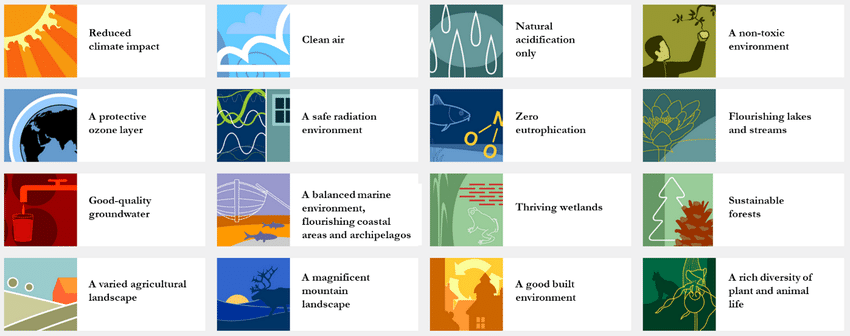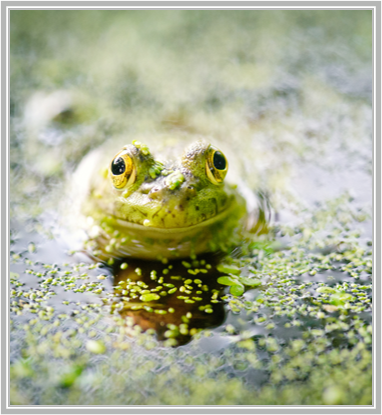This is how it works if you want to continue on another device
To save your progress if you want to continue on another device, there are several options. Copy or email a link, or read provided QR-code.
When you started the course, you will be able to continue on another device.
-
Read QR-code
Scan the following QR-code with your phone to continue where you left.
-
Copied
- Or email the link to yourself

Sweden's Environmental Objectives and Laws
Sweden’s environmental work is coordinated through the 16 environmental objectives, all of which aim to achieve the generational goal. International environmental goals are implemented in Sweden through the environmental objectives.

The Swedish environmental quality objectives. Illustration by the Swedish Environmental Protection Agency.
The latest in-depth evaluation of the environmental objectives from 2023 shows that:
- 1 out of 16 objectives were met
- 2 out of 16 objectives have a positive trend
- 4 out of 16 objectives have a negative trend
Different types of protected and valuable nature
In Sweden, nature is formally protected by environmental legislation. There are different types of nature protection with different purposes and with different geographical scales. From vast national parks to biotope protection covering specific objects, such as a stone wall. In addition to statutory protection, there are areas of nature that lack formal protection but are nevertheless protected from exploitation, e.g. voluntary considerations governed by certification.
In addition, various authorities such as the County Administrative Board, the Swedish Forest Agency and the Swedish Agency for Marine and Water management have identified valuable natural environments that lack formal and informal protection but are valuable for biodiversity. These areas provide a valuable knowledge base for planning, e.g. the layout of a new mine or limestone quarry, or the restoration of mining and quarrying environments.
Click on the different types of valuable nature to see examples:
Formally protected nature
National Park
Natura 2000
Nature reserve
Biotope protection (general and area protection)
Nature conservation agreements
Nature memorials
Set-aside forest (not protected)
Voluntary set-asides
Key biotopes
Consideration patches
Unproductive forest land
Unprotected nature with biodiversity value
Nature conservation areas of various types
Conservational value sites (Swedish Forest Agency)
Ecoparks
National interest for nature conservation
Valued areas
Bog protection plan
TUVA-database
NVI objects
Valuable waters (HaV)
Nature with red-listed species
Nature with protected species
Swamp forests
Urban nature
And more
Protected species: Species Protection Ordinance
Species are formally protected by the Species Protection Ordinance. Sweden has implemented two EU Directives through the Species Protection Ordinance: the Birds Directive and the Species and Habitats Directive.
An indicative ruling from the European Court of Justice in 2022 will tighten the requirements of the Species Protection Ordinance. A strict interpretation of the law and the guidance ruling could mean individual protection for all wild birds. Clarifications regarding the legislation will clarify the legal situation.


A government inquiry, SOU 2021:51 Protection of species – our communal responsibility, proposes to introduce different rules in the Environmental Code to implement the provisions of the Birds and Habitats Directives. It is proposed to make clear what the different parts of the Directives mean in Swedish circumstances, and the Directives are proposed to be implemented in separate provisions in Swedish legislation. One proposal in the inquiry is that offsetting measures must be taken in the event of an exemption from the Species Protection Ordinance.
